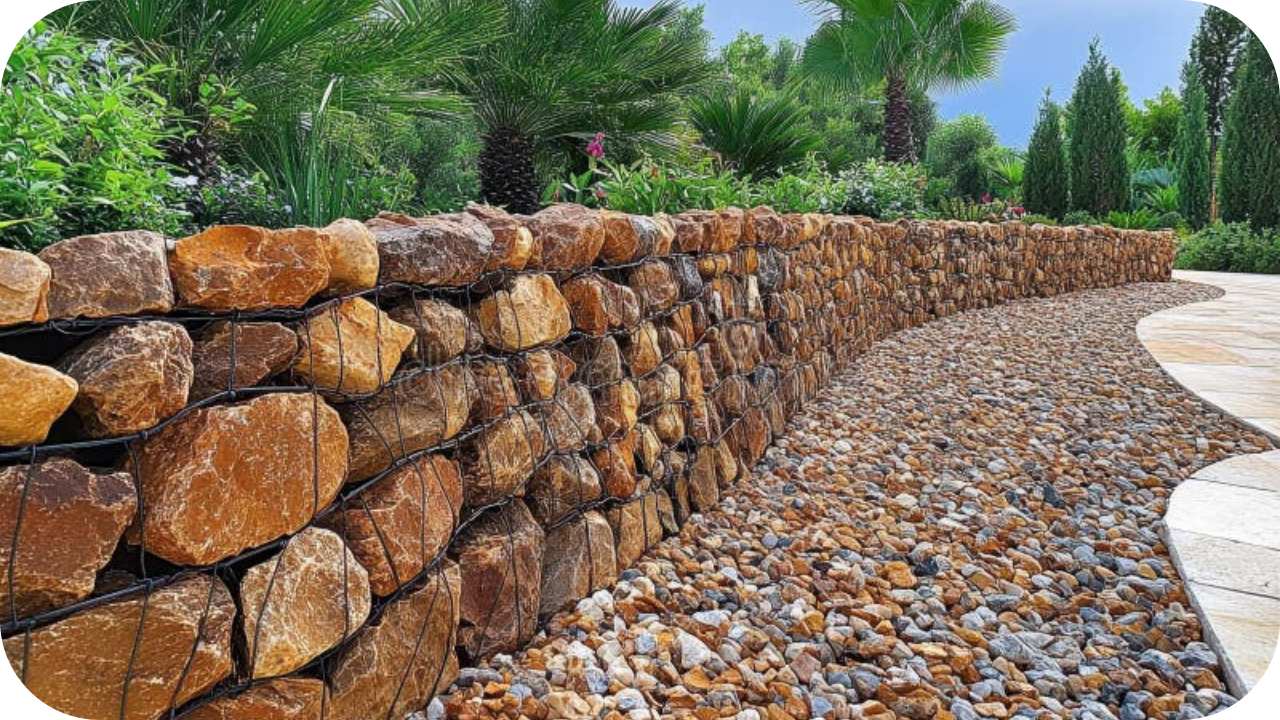
Tired of trudging through mud or navigating a weed-infested path?
A dull, uninspiring walkway can leave your entire garden feeling neglected.
But fear not! Stepping stones and pathways from the perfect stones can transform your garden into a functional and visually stunning retreat.
Importance of Stone Stepping Stones and Pathways in Garden Design
Stone stepping stones and pathways are more than functional elements guiding foot traffic through your garden. They strategically enhance your garden design in several ways:
- Structure and Organization: Clear pathways define designated walking areas, preventing damage to delicate plants and soil compaction. This creates a sense of order and makes navigating your garden more enjoyable.
- Aesthetics and Focal Points: Stepping stones and pathways made of attractive stone become design features themselves. The natural beauty of the stone complements your plantings, while strategically placed stepping stones can draw the eye towards specific areas of interest in your garden.
- Functionality and Accessibility: Paths provide dry, stable footing throughout the seasons, allowing you to access all areas of your garden with ease, regardless of weather conditions. They’re particularly helpful in wet or muddy areas.
- Reduced Maintenance: Compared to unpaved walkways prone to weeds and erosion, stone paths require minimal upkeep. This allows you to spend less time on maintenance and more time enjoying your garden.
- Versatility: Stone pathways and stepping stones can be adapted to any garden style. Rustic, irregular stepping stones contribute to a charming cottage-style garden, while sleek, geometric stone pavers suit a more modern or minimalist aesthetic.
- Connecting Spaces: Well-placed paths visually and physically link different zones in your garden. They can invite visitors to discover hidden nooks, guide them towards a focal point like a fountain, or create a tranquil journey through a lush flower bed.
- Defining Garden Rooms: Pathways can create visual boundaries and define specific areas within a larger garden, giving the illusion of “rooms” within an open space. These areas might include a vibrant flower bed, a relaxing seating area, or a hidden herb garden.
Flagstone: Natural Beauty and Versatility
Discover Flagstone’s timeless elegance and design flexibility for your garden pathways and stepping stones.
- Natural Beauty: Flagstone’s earthy colours (beiges, tans, browns) and unique surface variations enhance the visual appeal of your garden, blending seamlessly into various design styles.
- Safety: The naturally textured surface provides excellent grip even when wet, ensuring safe passage through your garden.
- Design Versatility: It is available in irregular shapes (for a rustic, natural look) and pre-cut pieces (for a more formal style). Slab thickness can also be varied, allowing for low-profile stepping stones and raised pathways.
- Durability: Flagstone, a natural stone, possesses inherent strength and will withstand the elements over time.
River Rock: Natural Charm and Texture
Bring a touch of riverbed serenity to your garden with the natural charm of river rock paths and stepping stones.
- Textural Appeal: Smooth, water-worn stones add a unique tactile and visual element to your garden design.
- Colour Variety: River rocks come in various hues (greys, browns, reds, yellows), allowing you to find the perfect complement to your garden’s colour scheme.
- Good Drainage: Their smooth surface and rounded shape promote efficient water drainage, minimising pooling and making them ideal for wet areas.
- Affordability and DIY-Friendliness: River rock is a budget-friendly option that is easy to install, even for those without landscaping experience.
- Consideration: Loose, rounded stones may require edging for paths to help keep them contained.
Slate: Rustic Elegance and Durability
Enhance your garden with the rustic charm and enduring strength of slate paths and stepping stones.
- Rustic Elegance: Slate offers a naturally textured, layered surface with subtle colour variations, creating a timeless aesthetic.
- Safety: The cleft surface provides excellent grip even when wet, minimizing the risk of slipping.
- colour Palette: Primarily found in rich grays, blacks, and purples, slate adds a sophisticated touch that complements various garden styles.
- Exceptional Durability: Slate’s resilience to cracking, fading, and erosion means your pathways will retain their beauty for years.
- Design Versatility: Available in natural cleft forms (for a more textured look) and pre-cut shapes (for a smoother, formal style).
Limestone: Soft Elegance and Timeless Beauty
Elevate your garden with the soft elegance and timeless beauty of limestone paths and stepping stones.
- Gentle Texture: Limestone offers a smoother surface than some alternatives, making it comfortable for walking barefoot.
- Subtle Colour Palette: Light and creamy hues (beiges, ivories) create a classic look and blend well with various garden styles, especially those with white or pastel tones.
- Moderate Durability: Limestone is resistant to cracking and can handle regular foot traffic but may be less suited for high-traffic areas.
- Consideration: While a smoother surface means less grip when wet, sealing your limestone path can help protect it from elements and reduce staining.
Choosing the Right Stone for Your Garden Stepping Stones and Pathways
With various stunning stones available, choosing the perfect one for your garden paths and stepping stones can feel overwhelming. Fear not! Consider these key factors to ensure your selection complements both your garden’s design and functionality:
- Style and Aesthetics: Consider your garden’s overall aesthetic. Flagstone and slate are rustic, while limestone and pre-cut granite lend a more formal touch. River rock adds a natural, meandering feel, while concrete pavers provide a modern minimalist look.
- Functionality and Use: Think about how your path will be used. High-traffic areas require a strong, durable stone like granite or bluestone. Flagstone, limestone, or river rock might suit lighter use or decorative paths. If wetness is a concern, prioritise stones with good drainage and textured surfaces for grip (like slate or flagstone).
- Climate and Maintenance: Local weather conditions can impact your choice. For freeze-thaw climates, select frost-resistant stones like granite or bluestone. Limestone may require sealing to protect it from harsh elements. Consider how much maintenance you’re willing to undertake. Loose materials like river rock may require edging, while pre-cut stones are generally easier to maintain.
- Budget: Stone prices can vary considerably. Limestone and river rock are budget-friendly options, while granite and bluestone are more expensive. Consider your budget and prioritize the features most important to you.
Installation and Maintenance Considerations
While stones offer beauty and durability, proper installation and regular maintenance are crucial to ensure your stepping stones and pathways remain a functional and aesthetic part of your garden for years. Here’s what you need to keep in mind:
- Installation: The process will vary depending on the type of stone and your desired path style. However, common steps involve preparing the ground, laying a base material like sand or gravel for stability, setting the stones, and filling gaps with jointing material.
- Edging: For pathways, edging prevents stones from shifting over time. Edging materials can range from natural options like wood or additional stones to metal or plastic edging.
- Drainage: Ensure proper drainage around your paths to prevent water buildup, particularly in clay soils. You might need to slope your path or slightly create a drainage area nearby.
- Maintenance: While stone is generally low-maintenance, sweeping away debris, occasional hosing to remove dirt, and sealing when necessary can prolong its beauty and prevent staining. For weed control in joints, options range from manual removal to eco-friendly solutions or jointing sand.
Conclusion: Benefits of Stone for Stepping Stones
So, ditch the muddy mess and elevate your garden with strategically placed stepping stones and pathways.
The perfect stone awaits to transform your garden into a functional work of art.
Now that you’ve armed yourself with the information in this guide, get out there and start crafting a beautiful path to a lifetime of garden enjoyment!
More To Explore

8 Advantages of Using Stone Grid Gabions in Your Landscape
Are you seeking a durable, cost-effective solution to elevate your landscape? Stone grid gabions might be the perfect choice! These versatile, eco-friendly structures offer a

10 Stunning Feature Wall Ideas Using Natural Stone
Looking to elevate your home with a stunning feature wall? Natural stone offers a timeless, elegant touch that can transform any room. From sleek marble


